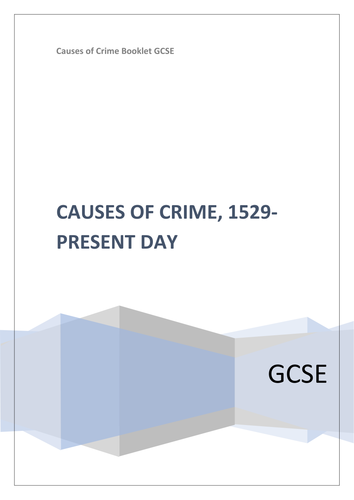
AN INFORMATION BOOKLET FOR GCSE STUDENTS OF CRIME, POLICING AND PUNISHMENT. THIS BOOKLET CAN BE USED AS A GUIDE TO THE COURSE AND AS A REVISION TOOL. THIS INFORMATION BOOKLET COVERS THE CAUSES OF CRIME ONLY. THE SPECIFICATION FOLLOWED IS DETAILED BELOW:
• Key Question One: What were the main causes and types of crime in Wales and England in the sixteenth and seventeenth centuries?
• The problem of vagrancy
• (causes e.g.: poverty, rural depopulation, unemployment; able-bodied poor and deserving poor; rogues and vagabonds)
• • The challenge of heresy
(causes e.g.: changes in religion and religious opposition; attitudes to heretics)
• • Dealing with treason
(definition of treason; a study of the Gunpowder Plot)
• Key Question 2: How did types of crime and their causes change in Wales and England in the eighteenth and nineteenth centuries?
• • Increase in smuggling
(reasons for the increase in smuggling; smugglers and excise men; attitudes towards smuggling)
• • Highway robbery
(issues involving stagecoach travel; lack of law enforcement; highwaymen and footpads)
• • The impact of industrialisation
(social and economic change; the development of large towns; examples of unrest leading to crime: Luddism, Swing and Rebecca Riots)
• Key Question Three: Why have there been new causes and types of crime in Wales and England in the twentieth and twenty first centuries?
• The rise of transport crime
(development of the motor car; creation of new crimes such as: car theft, drink driving, traffic offences)
• • The rise of computer crime
(computer fraud; stealing from bank accounts; hacking; viruses; identity theft, etc.)
• • The trend towards violent crime
(IRA bombings; football hooliganism; global terrorism; drugs crime; gun and knife crime)
• Key Question One: What were the main causes and types of crime in Wales and England in the sixteenth and seventeenth centuries?
• The problem of vagrancy
• (causes e.g.: poverty, rural depopulation, unemployment; able-bodied poor and deserving poor; rogues and vagabonds)
• • The challenge of heresy
(causes e.g.: changes in religion and religious opposition; attitudes to heretics)
• • Dealing with treason
(definition of treason; a study of the Gunpowder Plot)
• Key Question 2: How did types of crime and their causes change in Wales and England in the eighteenth and nineteenth centuries?
• • Increase in smuggling
(reasons for the increase in smuggling; smugglers and excise men; attitudes towards smuggling)
• • Highway robbery
(issues involving stagecoach travel; lack of law enforcement; highwaymen and footpads)
• • The impact of industrialisation
(social and economic change; the development of large towns; examples of unrest leading to crime: Luddism, Swing and Rebecca Riots)
• Key Question Three: Why have there been new causes and types of crime in Wales and England in the twentieth and twenty first centuries?
• The rise of transport crime
(development of the motor car; creation of new crimes such as: car theft, drink driving, traffic offences)
• • The rise of computer crime
(computer fraud; stealing from bank accounts; hacking; viruses; identity theft, etc.)
• • The trend towards violent crime
(IRA bombings; football hooliganism; global terrorism; drugs crime; gun and knife crime)
Get this resource as part of a bundle and save up to 95%
A bundle is a package of resources grouped together to teach a particular topic, or a series of lessons, in one place.
Something went wrong, please try again later.
This resource hasn't been reviewed yet
To ensure quality for our reviews, only customers who have purchased this resource can review it
Report this resourceto let us know if it violates our terms and conditions.
Our customer service team will review your report and will be in touch.
£1.00
